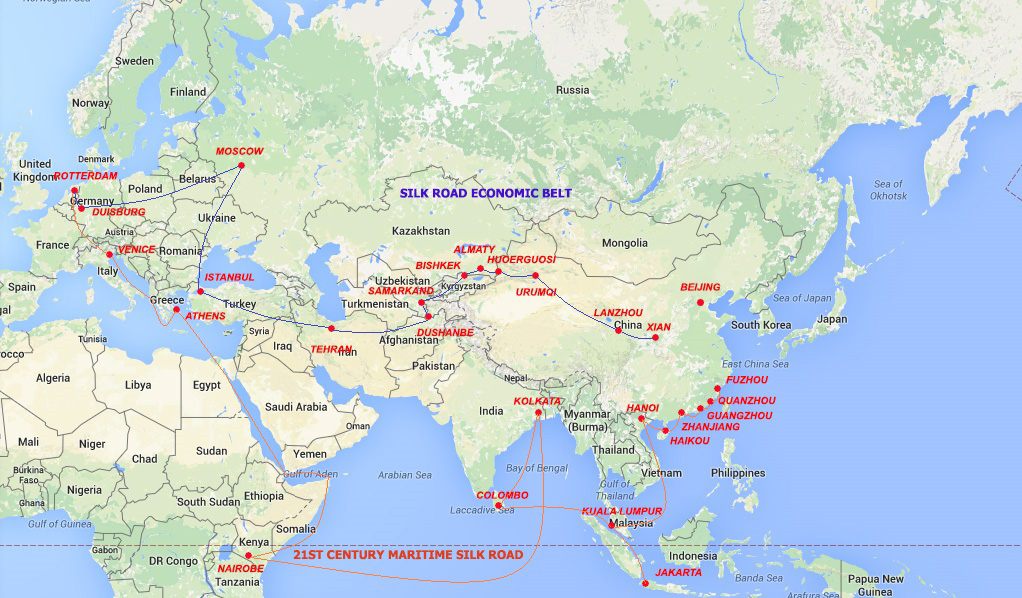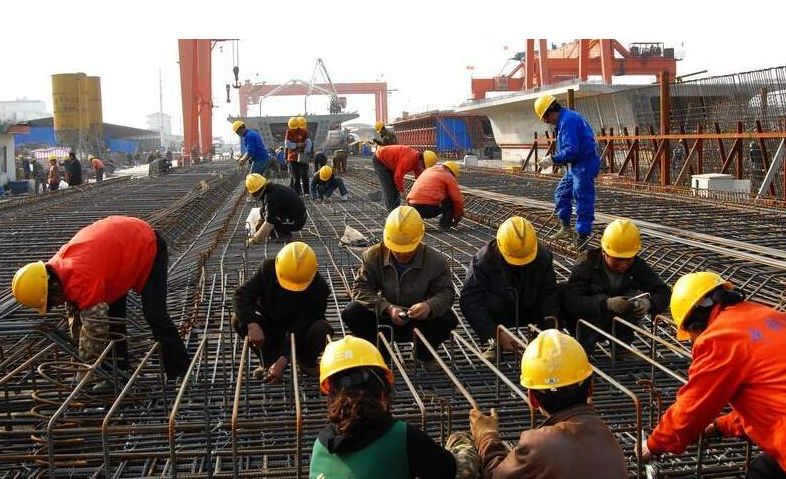https://www.hongkongfp.com/2016/03/06/explainer-chinas-one-belt-one-road-initiative/
6 March 2016
What is One Belt One Road?
One Belt One Road refers to the “Silk Road Economic Belt” and the “21st Century Maritime Silk Road.” Chinese President Xi Jinping first brought up the concept during foreign visits in late 2013. It is Xi’s signature world economic strategy.
One Belt One Road is not an entity or a treaty. It is a development initiative whose name was inspired by the ancient land and maritime silk road.
The Chinese government aims to connect China with the rest of Asia, Africa and Europe via land and sea. The initiative maps out five areas of cooperation with Belt and Road countries and regions: policy, infrastructure, trade, finance and people.

Ancient land silk road (red line) and maritime silk road (blue line). Photo: Wikicommons.
What countries and regions are involved?
Inside China, the “Silk Road Economic Belt” includes 12 provinces and one municipality, namely Xinjiang, Shaanxi, Gansu, Ningxia, Qinghai, Inner Mongolia, Heilongjiang, Jilin, Liaoning, Guangxi, Yunnan, Tibet and Chongqing.
The “21st Century Maritime Silk Road” includes four provinces and one municipality, namely Fujian, Guangdong, Zhejiang, Hainan and Shanghai.
Outside of China, over 50 countries are along the “belt” and the “road.” They include:
Asia: Philippines, Vietnam, Cambodia, Thailand, Malaysia, Singapore, Brunei, Indonesia, Myanmar, Nepal, Bangladesh, India, Pakistan, Sri Lanka, Mongolia, Maldives, Kazakhstan, Kyrgyzstan, Tajikistan, Uzbekistan, Iran, Kuwait, Bahrain, the United Arab Emirates, the Sultanate of Oman, Qatar, Israel and Saudi Arabia, Hong Kong, Macau, Taiwan.
Africa: Kenya, Sudan, Egypt and Djibouti.
Europe: Russia, Georgia, Armenia, Azerbaijan, Cyprus, Turkey, Greece, Italy, Switzerland, Austria, Hungary, Serbia, Romania, Moldova, Germany, the Netherlands.

The “Silk Road Economic Belt” and “21st Century Maritime Silk Road.” Photo: HKFP.
What bothers people about One Belt One Road?
No country has spoken out against One Belt One Road but the West is generally wary of China’s effort to increase its clout over international affairs. The One Belt One Road initiative is seen by some as Beijing’s effort to change the world’s power dynamic and establish new rules to its standard. The initiative will help Chinese companies expand overseas and push the global use of the Chinese currency Renminbi.
Besides the China-centric concern, countries worry that Chinese companies may not uphold existing international standards of corruption prevention, environmental protection and human rights protection in carrying out Belt and Road projects.
What agreements and deals have been made under One Belt One Road?
Asian Infrastructure Investment Bank: AIIB was established to support infrastructure construction in the Asia-Pacific region. So far 57 countries have signed the AIIB Articles of Agreement to be founding members: Australia, Austria, Azerbaijan, Bangladesh, Brazil, Brunei, Cambodia, China, Denmark, Egypt, Finland, France, Georgia, Germany, Iceland, India, Indonesia, Iran, Israel, Italy, Jordan, Kazakhstan, South Korea, Kuwait, Kyrgyzstan, Laos, Luxembourg, Malaysia, Maldives, Malta, Mongolia, Myanmar, Nepal, Netherlands, New Zealand, Norway, Oman, Pakistan, Philippines, Poland, Portugal, Qatar, Russia, Saudi Arabia, Singapore, South Africa, Spain, Sri Lanka, Sweden, Switzerland, Tajikistan, Thailand, Turkey, UAE, United Kingdom, Uzbekistan, Vietnam.
The China-Pakistan Economic Corridor: the 3,000-kilometre corridor spans from Kashgar in Xinjiang to Pakistan’s Gwadar port. The two governments plan to build highways, railroads, gas and oil pipelines as well as communication cables along the corridor. The two governments have signed projects worth US$46 billion.

Chinese workers building an elevated railroad in Kenya. Photo: news.163.com.
The Mombasa-Nairobi Railway: the railway in planning will connect Kenya’s capital with its southeastern coast. It will span 2,700 kilometres and is expected to cost US$25 billion. China sees Kenya as its Belt and Road strategy’s key strategic partner in Africa.
Other infrastructure projects include the Jakarta-Bandung Railway in Indonesia, the Moscow-Kazan Railway, the Kunming-Vientiane Railway, the Kunming-Bangkok Railway and the China-Belarus Industrial Park.
What does One Belt One Road mean for Hong Kong?
Chief Executive Leung Chun-ying in this year’s Policy Address said Hong Kong should proactively respond to the One Belt One Road initiative and grasp opportunities provided by its projects. However, analysts say Belt and Road means little to the average Hong Kong citizen. The most likely benefit for the city will be potential financial opportunities for infrastructure projects.
Because Belt and Road projects especially in Africa and Asia require huge amounts of money, Hong Kong can provide the financing via bonds, stocks and IPOs for Chinese companies seeking funding. Hong Kong can also provide international connections and legal expertise for Chinese firms when they sign contracts with overseas partners.
No comments:
Post a Comment